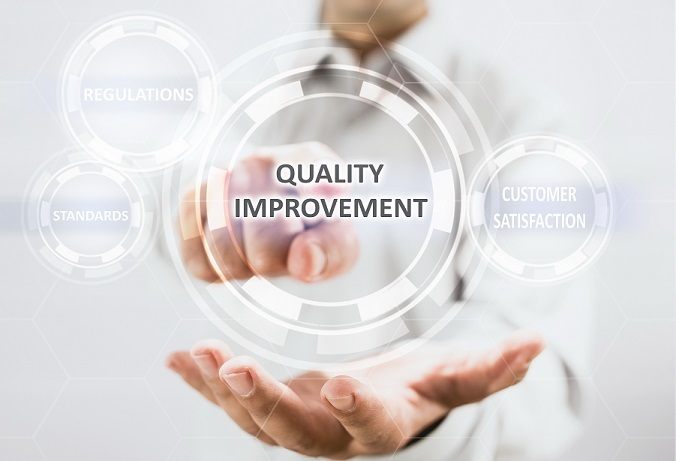Tag Archives for " hospital management "

Quality Improvement Performance Indicators: Prioritizing Your Data
In a recent blog post, the Center for Improvement in Healthcare Quality shed some light on an area of concern for many hospitals: the prioritization of data collection within their QAPI program. Hospitals are constantly working to monitor, report on and improve patient safety and quality of care, many of them collecting data on hundreds of performance indicators, but it’s impossible to monitor every single area.
This is where prioritization of data collection comes into play. The Centers for Medicare and Medicaid Services expects hospitals to prioritize high-risk, high-volume or problem-prone areas, but unfortunately, the agency is not specific on what areas qualify as such. However, the CIHQ suggests prioritizing performance indicators that are frequently cited for not being incorporated into a hospital’s QAPI program, such as:
Medication Use
- Sterile Compounding and IV Admixture
- Management of Hazardous Medications
- Medication Administration Practices for High-Risk Meds
Infection Prevention & Control
- Sterilization of Instruments & Supplies
- High-Level Disinfection of Instruments & Supplies
- MDRO and Isolation Practice
- Disinfection and Cleaning of Dialysis Machines & Equipment
Physical Environment
- Environmental Controls of Sensitive Areas (Temperature, Humidity, Air Balance)
- Maintenance and Operation of Critical Medical and Utilities Equipment
- Life Safety System Testing and Maintenance
- Implementation of Interim Life Safety Measures
- Protection Against Radiation Hazards
Food & Nutritional Services
- Food Service Preparation, Storage, and Cleanliness
Clinical Services
- Ordering Restraint & Seclusion
- Monitoring of Patients in Restraint & Seclusion
- Administration of Blood & Blood Products
- Protection of Patients at Risk of Self-Harm
- Administration of Sedation / Anesthesia
- Surgical and Invasive Procedures
While we support CMS and CIHQ in urging focus on certain performance indicators when a limited number can be tracked and addressed, hospitals should be very careful about reducing the number of tracked indicators due to time and resource constraints, because that could potentially have a damaging effect on the organization. The motivation to do so is often present and understandable, when hospitals are utilizing inefficient and labor-intensive performance tracking processes and tools. This is precisely the fundamental issue that Prista’s ActionCue CI application was designed to address.
ActionCue CI is your Fast Path to Insight™, monitoring all 19 performance indicators listed above and more, right out of the box. Its intuitive online dashboards provide critical QI/PI information to those who need it, when they need it. With gains in efficiency and productivity from using ActionCue CI, staff can carry out the quality, safety and improvement activities of the hospital, and cover and drive improvement on a larger number of measures, reducing the chances of being blindsided by a clinical performance issue or a derogatory survey finding.
In addition to comprehensive and efficient data collection, ActionCue helps hospitals take real actions to improve patient care, allowing staff to quickly investigate event causes and manage corrective actions through electronic event reporting. Many hospitals see significant increases in staff participation, communication and cooperation.
While it’s certainly important to take all necessary steps to avoid a CMS citation, ActionCue helps hospitals take quality and performance improvement a step further by truly creating a “Culture of Quality,” representing a collective and sustained commitment by organizational leaders to emphasize safety every single day.

Re-Thinking: Four Ways to Advance Healthcare Quality and Safety
For decades, I practiced and taught others a model of developing new software products in which the creator begins with at least two innovation concepts before thinking about technology choices, features or even architecture. These concepts must represent a new way to reach important objectives, not just tweak current tasks and activities. They must eliminate current hurdles and transcend problems. This model has proven to be the best way to ensure that the benefits of the product stem from fundamental values, are sustainable, provide room for growth, and build on an evergreen strategy.
In some cases, healthcare staff, management and executive IT users are hesitant to change the way they do things, but such changes have been proven to be the only way to make substantive progress. These innovative concepts are at the core of Prista’s ActionCue Clinical Intelligence platform, helping healthcare professionals reach real quality improvement goals that are fundamental in alleviating the operational, financial and regulatory issues with which hospital leaders wrestle every day. Even if hospital leaders believe the quality and safety activities in their organization are productive and successful, we believe those activities could be significantly more effective, positively impacting patient outcomes, revenue, staff workload, management and executive participation, and the culture of quality in the organization. The following are four ways healthcare organizations and management can advance healthcare quality and safety.
1. Shift focus toward goals instead of traditional activities
For individuals and organizations, doing “what we’ve always done” is comforting, pays respect to past decisions and accomplishments, and, importantly, avoids any risk in trying to improve by doing things differently. Some will focus on “risk” in that statement; others on “better.” Improvement, something we discuss often, inescapably means change, and the degree to which we avoid changes in process can systematically limit improvement. The tendency is to start rationalizing complacency and praising stability, solidarity and tradition.
The problem with the willingness to hold on to traditional activities manifests itself when organizations maintain the functional silos of Quality, Risk Management and Performance Improvement in hospitals. Whether individuals, groups or entire departments, tradition supports these institutions having different leaders, processes, tools, methodologies and data. With these functions compartmentalized, their objectives—and rewards—are limited to their respective stages of development instead of contributing to the overall goal of improvement. Simply reporting metrics and incidents is the finish line for some, while others carry on with other activities. This leads to dependence upon human endeavor to unify all those differences, in traditional mechanical ways, to serve the goal all healthcare organizations should be working toward: better patient care and outcomes delivered with efficiency.
The ActionCue application provides innovative consolidation of all performance metrics. No more silo-ing of core measures, audits, EOC, or protocols. Event reporting and investigation and improvement action plans are highly integrated. All data and information flows together and is readily accessible, enabling each task and activity to tie into performance improvement. Not only does this design serve the common goal better, it saves the staff, managers and executives a lot of time and mental exertion.
2. Own quality-safety improvement internally and make it efficient
Historically, most of a hospital quality department’s activities were focused on submitting data, reports and documents to external regulators and other stakeholders. A good portion of that information is intended for licensure/accreditation, long-term research and, especially in recent years, reimbursement. The aim in hospitals, typically among overworked managers, has become to “check the box” noting required submissions have been accomplished. Using the compiled information internally to improve quality and safety has become secondary to executives looking for checked boxes, and such perspectives tend to trickle down as real and perceived guidance. Yet, the return and yield from the submissions to those external organizations, in terms of enabling patient care improvement, is usually disappointing and always later than desired. With that view of comparative value, it is sometimes difficult for clinicians to remain motivated to genuinely improve quality and safety, and it’s equally difficult to get budgetary investment for innovative, efficient tools and processes as opposed to maintaining the traditional—and sub-optimal—activities and approaches.
ActionCue is far more than a reporting tool. It is a composite platform for the entire clinical staff, management and other stakeholders to work collaboratively and efficiently, while pursuing continuous improvement, which has long been little more than a slogan or buzzword. Its value in executive awareness and required reporting is exceptional. Users report a near elimination of “survey preparation” and surveyors from several states, as well as accreditors such as CIHQ, TJC and DNV, have commended its clarity, accessibility, accountability and demonstrated utilization and results.
3. Improve division of labor between humans and technology
Many healthcare IT users have come to understand that many applications are little more than an electronic filing cabinet, mostly utilized for storage and retrieval of information in the same format as that in which it was input. This places a burden on staff to compile commonly used information, perform calculations, and turn raw data into intelligence and insight. For a long time, organizations’ leaders have accepted that quality and safety efforts require a large amount of time and effort in mundane process mechanics. Applications serving important enterprise functions should focus on collaboration and workflows that not only match the natural tasks and processes of users, but also shape the users’ behavior by embodying methodologies and disciplines that yield the targeted results with efficiency and accountability.
Additionally, when the application is designed to partner with the user in his or her work through well-known, disciplined workflows, it can provide valuable, relevant, up-to-date content in the context of the task at hand, such as researched industry and academic performance measures, evolving best practices, educational materials, forms, contact information and a wealth of other materials the user, or the user’s work group, no longer have to spend time researching, compiling and updating. This sort of sophisticated, enabling design should become commonplace in healthcare IT applications, as it has been for decades in other fields.
ActionCue’s design goes beyond ease-of-use to advance the way in which healthcare organizations engage with information in an application. The platform proves to be an enjoyable working team member, increasing productivity and facilitating education and improvement towards goals. ActionCue users develop and maintain a strong “Culture of Quality.
4. Opt for a turnkey application utilizing a SaaS model
The technology used to support hospitals’ important quality and safety work usually starts out as a “toolkit” in which the organization invests a lot of time, money and attention to build and maintain the intended “solution.” Ranging from paper and Excel spreadsheets, to internally developed tools and applications, to major commercial systems that undergo extensive customization by their vendors and “add-on” technicians and analysts, healthcare organizations spend a lot of money and resources—often incrementally staffing consultants and specialists— to get the job done. Despite the high costs, many organizations believe such an approach is the only one that will work, and it is often based largely on what they have used historically. In such a setting, real innovation is rare and very expensive.
When an application provider has utilized healthcare expertise in its core design, delivery and support functions, it can anticipate a great deal of the functionality needed by its users and apply best practices to deliver a “turnkey application,” ready to run right after the sale. Foregoing full customization can be readily accepted as a trade-off for saving tens of thousands of dollars (or more) in visible and hidden costs. Turnkey applications also frequently have value-adding content that is continuously researched and updated, providing constant improvement in the use of the application. Setting a high bar when reviewing turnkey applications and providers has long been the standard approach for organizations of all sizes outside of healthcare that are adept at considering total cost of ownership (TCO).
The next step forward in evaluation of a solution is the true Software as a Service, or SaaS, business model. With the fundamental distinction of being web-based and accessed via a browser, SaaS applications save buyers a great deal by avoiding the costs of acquiring and maintaining expensive computing and storage infrastructure to support on-premise systems. Leading companies offering SaaS model applications go much further than “renting software,” thought by some to be an unnecessary expense. The best practitioners of the SaaS model accomplish three major things that are impossible, difficult or very expensive with other models.
- Update the application frequently: Because the process of distributing updates is simpler and less expensive than with on-premise software, SaaS-model companies frequently provide quarterly or even monthly updates. Such updates typically include enhancements and extensions of functionality, as well as adaptations required by regulators and other authorities in healthcare. This same advantage in efficiency makes it possible and likely that the delivery of software corrections and “fixes” can take place in hours, instead of weeks or months, as is often the case with on premise software.
- Operate efficiently and pass savings on to customers: SaaS-model companies operate on the latest technology platforms, facilitating rapid development and deployment of changes, making them far easier and less expensive to maintain. Companies that have started out as such build their entire operations around utilizing the most up-to-date technologies and methodologies, so their internal operating expenses are lower than those of traditional software companies. These and other efficiencies allow SaaS-model companies to pass their savings along to customers, driving down prices, usually as non-capitalized monthly or annual subscriptions.
- Provide proactive, expert support: Unrelated to the technology side of the SaaS model, the best of these providers work on the principle of an ongoing collaboration with each of their customers. The frequent updates and efficient operations mentioned above allow SaaS-model companies to focus on providing support staff that are highly skilled, have in many cases done the work of the very users they support, and are responsive to, or anticipatory of, the evolving needs of their customers. In the case of healthcare quality, safety and improvement efforts, this approach involves leveraging research on evolving performance measure definitions, best practices, and information submission mandates carried out by the support staff, and integrating them into the application for all to use, saving a great deal of the users’ time.
Understanding what SaaS-model companies represent and offer, healthcare executives can appreciate that this means of operating is exactly what is needed in the strategic advancement of healthcare information technology.
As a fully actualized example of a SaaS-model offering, Prista and its ActionCue application transform the relationship an organization has with its information technology. No longer a bottom-line cost, source of frustration for staff, or drain on productivity, ActionCue is a critical facilitator of clinical performance improvement, providing tactical and strategic benefits for the organization’s people and processes, and delivering ROI.
Taken one by one, any of these departures from the status quo would be valuable and beneficial to a hospital and even more so for a healthcare system. Each of these steps forward would be truly strategic, with broad and long-term positive effects. But taken altogether, these changes in thinking and the realization of them in a platform like ActionCue Clinical Intelligence is truly a transformational step forward for healthcare organizations.
Alarm Fatigue — Do You Have It?
 I know you can relate to this situation. You’re walking through a parking lot when suddenly a car alarm starts going off and doesn’t stop, and (I’m willing to bet), you keep on walking without looking back. Sound familiar?
I know you can relate to this situation. You’re walking through a parking lot when suddenly a car alarm starts going off and doesn’t stop, and (I’m willing to bet), you keep on walking without looking back. Sound familiar?
When car alarms first emerged back in the 80s they were few and far between. The ear splitting sounds of the alarms turned heads of onlookers, to what could be a serious situation in need of attention. It didn’t take too long, however, for us all to become desensitized to the familiar warbles and chirps, and we no longer paid any attention to them — defeating their purpose.
The same desensitization, or fatigue, happens with clinical alarms in hospitals. But, there are ways to help reduce alarm fatigue according to a study published in Pediatrics.
In the study researchers at Cincinnati Children’s Hospital Medical Center, led by Christopher Dandoy, M.D., of the hospital’s Cancer and Blood Diseases Institute, found that a standardized, team-based approach could dramatically reduce alarm fatigue — helping to eliminate the possibility of not responding to a true event.
The researchers created a standardized cardiac monitor care procedure for the hospital’s 24-bed pediatric bone marrow transplant unit.
As part of the project, Dandoy and his team developed a process for ordering monitor parameters according to age-appropriate standards, pain-free daily electrode replacement, personalized daily cardiac monitor parameter assessment and a reliable way of appropriately discontinuing monitors. Under these protocols, the median number of daily cardiac alarms fell from 180 to 40, while caregiver compliance increased from 38 percent to 95 percent.
“Cardiac monitors constitute the majority of alarms throughout the hospital,” Dandoy said in a hospital announcement. “We think our approach to reducing monitor alarms can serve as a model for other hospitals throughout the country.”
Fewer false alarms, he added, will allow hospital staff to devote more attention to significant alarms. Although the process was enacted in a pediatric unit, Dandoy and his team said it was applicable to “most units with cardiac monitor care.”
“Hospitals are greatly concerned about alarm fatigue because it interferes with patient safety, and it exposes patients–and the hospitals themselves–to grave harm,” said Michael Wong, executive director of the Physician-Patient Alliance for Health & Safety, who presented findings at the Society for Technology in Anesthesia, earlier this year that hospital staff are exposed to an average of 350 alarms per bed, per day based on a sample from an intensive care unit at the Johns Hopkins Hospital in Baltimore.
Cincinnati Children’s Hospital Medical Center says nationwide adoption could increase patient safety
You can read the full study here.
Evidence-based protocols drive quality improvement
An article published in FierceHelathcare’s eBook “Systemwide Transformations that Improve Healthcare Quality and Efficiency.” argues the best way to treat patients is with evidence-based protocols (EBPs).
Here is an excerpt:
In a new and evolving healthcare market that rewards efficiency and quality care, hospitals must find a way to streamline their systems to put forth better results for patients and more savings for their organizations.
One way to accomplish this is by focusing on evidence-based care protocols–the clinical care recommendations supported by the best available evidence in the clinical literature.
Although there may be 200 ways to do something, in some cases clinicians have strong evidence that reveals the best way to do it, says David J. Ballard, M.D., Ph.D., chief quality officer for Baylor Scott & White Health, a not-for-profit healthcare system based in Dallas that includes 46 hospitals and more than 500 patient care sites. For instance, Baylor implemented a standardized heart failure order set, which has the potential, if it were deployed across the country, to save $2 billion in annual hospital costs and prevent 1,500 in-hospital deaths annually.
The results of EBPs are better care for patients, and cost savings for healthcare organizations.
You can read more about Evidence-Based Practices here.
4 Great Tips for Any hospital CEO
 Hospital CEOs today bare an enormous weight of increasing healthcare quality and performance, while at the same time reducing costs. It is an overwhelming task for even seasoned healthcare executives — one that is made more difficult for many new CEOs who are just starting out and are battling age, and experience gaps.
Hospital CEOs today bare an enormous weight of increasing healthcare quality and performance, while at the same time reducing costs. It is an overwhelming task for even seasoned healthcare executives — one that is made more difficult for many new CEOs who are just starting out and are battling age, and experience gaps.
In an exclusive interview with FierceHealthcare, Nicholas R. Tejeda, CEO of Doctors Hospital of Manteca (Calif.), a 73-bed facility affiliated with the Tenet Healthcare Corporation, talks about his own experience with experience-related perceptions, and offers some excellent leadership advise to hospital executive who find themselves in similar situations.
In the article, Tejeda offers this:
- Communication matters: Appearances do count, he said, which means you can’t dress and act young. “You can’t have spikey hair when you are young leader. Don’t act like a kid. It’s the message that matters.”
- Respect the past: Young CEOs need to learn from the past and integrate those lessons into future decisions, he said. “Often people want to dismiss the past and forget the shoulders they are standing on. Ask about the past but don’t lose sight of the fact that you are supposed to translate those decisions to the future journey,” Tejeda said.
- But look to the future: “If people see you are doing things that benefit the organization in the long term, it will go a long way and they will begin to trust your decision-making and your willingness to work,” he said. “Don’t just do short-sighted things, like yelling, firing or making immediate cost-saving opportunities.”
- Express curiosity: To overcome negative assumptions that staff will make about you as a young leader, take advantage of some expectations that work in your favor. For example, many staff think of young leaders as full of energy and eager to prove themselves. “If they expect it, allow it to be a tool and allow more experienced employees to implement what they want to do if it makes good business sense,” he said. Once staff see that you will take action and get organizational support for their projects, Tejeda said, even the youngest leader can quickly develop credibility and gain employees’ trust.
Though his comments were in response to issues facing younger executives, this is excellent advice, regardless of age or experience level. Engaging with staff to learn, and build trust is more important now than ever before.
With the number of changes and demands on healthcare facilities from both insurances and government entities, hospital staff is increasingly overwhelmed, and look to their leadership to chart a course through to calmer seas and better patient care. To help get there, CEOs should be willing to look for the insight and experience of their staff.
